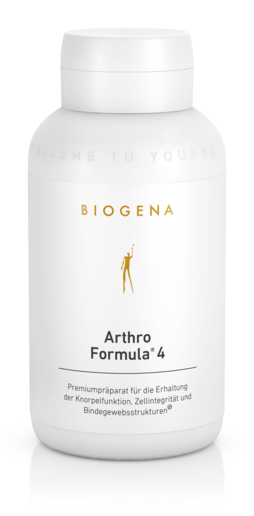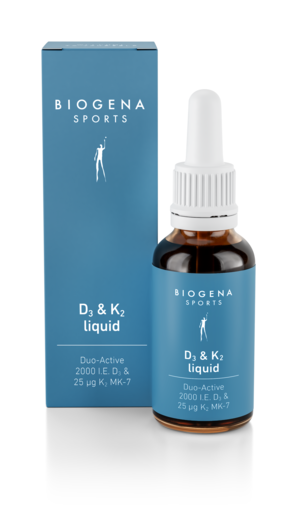Bones and joints
Most people only deal with the subject of strong, healthy bones in the second half of their life. This is the case if a bone density measurement shows that there is already excessive bone degradation.It is now necessary to act.


Bones & Joints
Movement, movement, movement. This is the key to strong bones and joints. A varied diet with many vitamins and minerals also supports you well into old age.
Strong bones form at a young age
Bone metabolism is a complex process that – depending on age – is predominated by build-up or degradation processes. In the early years of life, it is important to build up as much bone mass as possible. The maximum bone density is reached between the ages of 30 and 35. From then on, the degradation processes predominate.
Unser Tipp
The stronger and more robust the bones become at a young age, the less dramatic the consequences of natural degradation in old age.
Wie erkennst du, ob du Supplements für Knochen benötigst?
Of course, the right nutrition with all essential nutrients is key. Sufficient movement with impact loads on the bones (e.g. by jumping) is also necessary to increase bone mass. This is because the skeleton is stressed, and the minerals from food are increasingly integrated into the bone structures.
Our contribution: prevention through early detection on-site
By offering free and uncomplicated bone density tests in your neighborhood, BIOGENA wants to help prevent millions of years of suffering and hundreds of thousands of deaths through prevention and education.
The "Strong Bone Bus" travels wherever enough people are enthusiastic about proactive prevention and want to take responsibility for their health. A certified device can then be used directly on-site to make well-founded statements about bone density in just a few minutes and recommend immediate action for further examinations and lifestyle and dietary modifications:
Menopause and bone density – the moment of truth
With the onset of menopause, bone loss suddenly becomes an issue for women. The reason for this is the increased degradation rates during the first five years after menopause (menopause is defined as the time of the last menstrual bleeding; this occurs in most women around the age of 50). If the age-related decrease in bone density in younger years is on average 1.5% annually, this increases to up to 5% after menopause. A bone density scan may be useful during this time. This is because, if osteoporosis or the precursor stage osteopenia is detected promptly, it can still be counteracted.
High-risk lifestyle – that influences your bones:
Although a lack of bone density is usually considered to be a women's topic, other risk factors are known in addition to the female gender:
- The regular use of certain medications (e.g. proton pump inhibitors to protect the stomach or cortisone against inflammation) disrupts the supply of necessary minerals to the bones.
- On the other hand, lactose intolerance is only a problem for bone metabolism if other sources of calcium are missing from the diet. Mineral water, nuts, various herbs and vegetables, seaweed, soy, and coconut milk provide a good basis. Special calcium supplements can complement a basic dietary regime.
- The same applies to a vegan lifestyle. Here, attention must be paid not only to vitamin B12 but also to the mineral calcium. However, it has now been proven that high doses of calcium are not enough to keep bones healthy. Many other minerals and vitamins are necessary for the development and maintenance of healthy bone structures. A vegan diet has advantages over the average diet.
- One clear risk factor for bone loss is lack of exercise. Moderate muscle training also helps to strengthen the bones. Short interruptions of inactivity (e.g. regularly getting up from screen work) are more effective for the bones than a long inactive phase followed by a long active phase as researchers found out in the American National Health and Nutrition Examination Survey (NHANES).
Tips to strengthen your bones: What you can do for your bone health
Vitamins, minerals and bone metabolism
A sufficient supply of bone-relevant nutrients plays a significant role in strong bones both in our youth and as we get older. In addition to a nutrient-rich, alkaline-accentuated diet, adequate vitamin D should also be provided throughout the year – i.e. moderate sunbathing in the sunny season, and vitamin D substitution when the days are short and dark.
Spontaneous reaching for a calcium supplement is obvious, but it has no health benefit for the bones. The unilateral increase in calcium intake as protection against osteoporosis has unfortunately proven to be ineffective. The analysis of data collected for decades shows no evidence, i.e. no scientific evidence, that calcium carbonate alone can influence bone density. One explanation for this is vitamin D, which plays a central role in several functions in bone metabolism.
Vitamin D is not only necessary for the absorption of calcium from the intestine into the body, it also regulates the storage of calcium in the bones. In addition, vitamin D improves muscle strength in those over the age of 60 and reduces the risk of falling and thus the risk of bone fracture by about 22%. However, at least 20 μg vitamin D are required daily for this (equivalent to 800 IU).
Other micro-nutrients are necessary for bone metabolism. For example, magnesium, which also ensures strong bones. And vitamin K, which is either produced by our intestinal bacteria (if we have healthy intestinal flora) or absorbed through food (if we have enough vegetables and offal in our diets). Vitamin K is necessary for the formation of osteocalcin, a protein that binds calcium and hydroxyapatite as a matrix in the bones and thus increases bone density. The central role of vitamin K in the maintenance of bone mass is still given too little attention.
Avoid over-acidification
A high proportion of animal protein in food and industrially processed foods leads to excess acid in the body. To compensate for this, basic minerals are required, which are found above all in unprocessed plant-based foods. If these are missing, minerals are released from the deposits, i.e. in the bones, and ultimately excreted via the kidneys.
Improve bone density with your diet
A balanced diet with many fresh ingredients forms the basis for bone stability and is a strong weapon against bone loss and osteoporosis.
Food for strong bones
| Examples | Bone bonus | |
| Green vegetables & green culinary herbs | parsley | All contain large amounts of vitamin K and magnesium. Valuable alkalis |
| Pseudo cereals | Buckwheat, amaranth, quinoa | Often rich in minerals such as calcium, magnesium, potassium, and zinc |
| Nuts, kernels, seeds | Almonds, sesame, linseed, poppy | Good suppliers of calcium, magnesium, and boron |
| Soya products | Soya beans, tofu, saitan, tempeh | Provide Isoflavones, potassium and magnesium. |
| Mineral water with a high calcium content | Provides calcium as well as potassium and magnesium in different concentrations |
Table 1: Food for strong bones
Exercise & sport: Fit body, fit bones
Movement, movement, movement: Swimming and cycling are good for muscles and the cardiovascular system. However, these activities play a limited role in maintaining bone density. Only movement that exerts pressure on the bones (e.g. gymnastics, strength exercises, Nordic walking, hiking, cross-country skiing, or dancing) improves bone strength. And of course, all ball sports are good for bone mass.
Nicotine gnaws at the bones
The fact that smoking is bad for our health is not something new. But did you know that smoking can also damage our bones? Cigarette consumption narrows the blood capillaries – and so the supply of bone nutrients worsens. Giving up smoking is often worthwhile – not least for the sake of your bones.
Hello, normal weight!
The golden middle way in life is true in many aspects – also when it comes to bone-friendly weight. If you are overweight, the extra pounds place stress on your bones and make exercise – which is so important to them – more difficult. Chronic underweight can also consume your bone stability, as this is often associated with a lack of nutrients – and in women – with the bone protection hormone estrogen.
Conclusion: Healthy bones is a long-term project
Bone mass increases over the years and unfortunately also decreases. It begins at a young age when the foundation for high bone density is laid. A varied diet with a focus on vitamins and minerals, coupled with a healthy lifestyle and lots of exercise, is the basis for stable bones into old age. At the latest when entering menopause, women should once again pay attention to their bone density in a targeted manner, because from then on, the rate of degradation increases. If medications are used over a longer period, the topic of osteoporosis should also be discussed with the treating physician, and preventive measures taken.
If you want to be on the safe side, you can specifically supplement bone-active nutrients in every phase of your life. However, pure calcium preparations are useless, as we know today. Effective products are combination products containing at least calcium, vitamin D and vitamin K.
Supplements für Gelenke
Strong joints: What keeps the knee moving?
A good supply of nutrients
The four important natural cartilage nutrients glucosamine, chondroitin, native collagen, and hyaluronic acid form the structures of the cartilage, bind water and thus ensure the smooth functioning of the joints in the truest sense of the word.
In addition, vitamin C contributes to the formation of collagen for normal cartilage and bone function, while manganese supports the formation of connective tissue. Together with copper and selenium, they help to protect the cells from oxidative stress. In the case of a reduced supply of nutrients, the joint cartilage “starves” and the normal cartilage function is impaired. The elasticity of the cartilage decreases and is degraded. If the cartilage function is unbalanced, then the bones rigidly rub against each other.
Movement
In addition to a sufficient nutrient supply, regular physical activity is also decisive for ensuring that the cartilage can be supplied with valuable nutrients. No high-performance sport needs to be carried out for this; simply going for a walk is enough. In this way, the joint fluid is circulated at each step – i.e. with every bend and stretch. In this way, constructive nutrients are transported to the cartilage and unfavorable waste materials are transported away from the cartilage. Since people with knee problems move less, cartilage care is often limited. A vicious circle.
Frequently asked questions about bones











